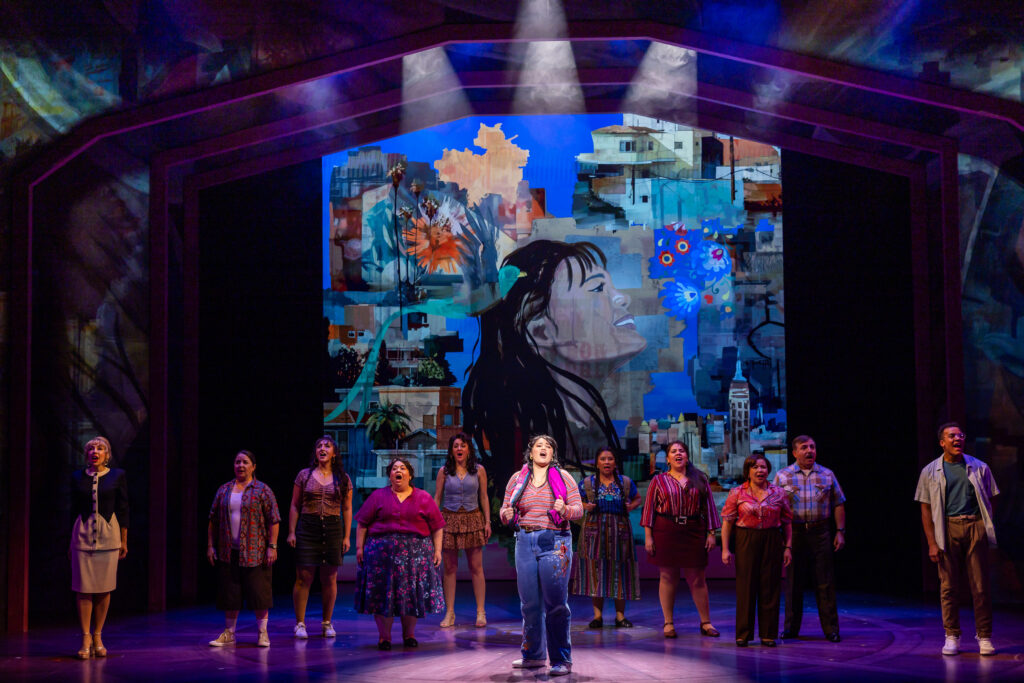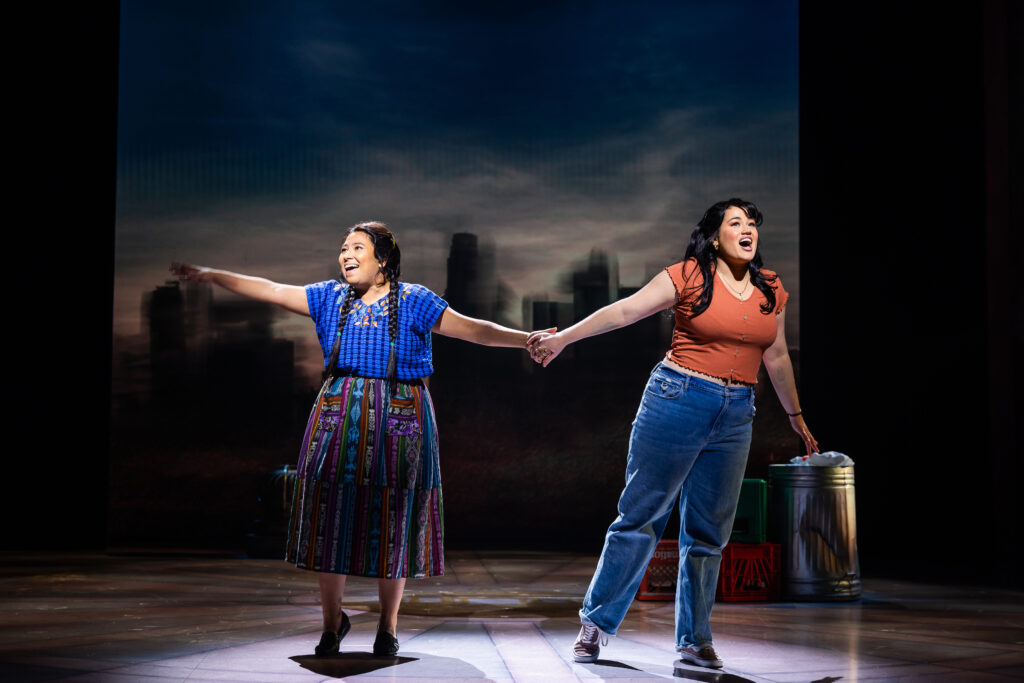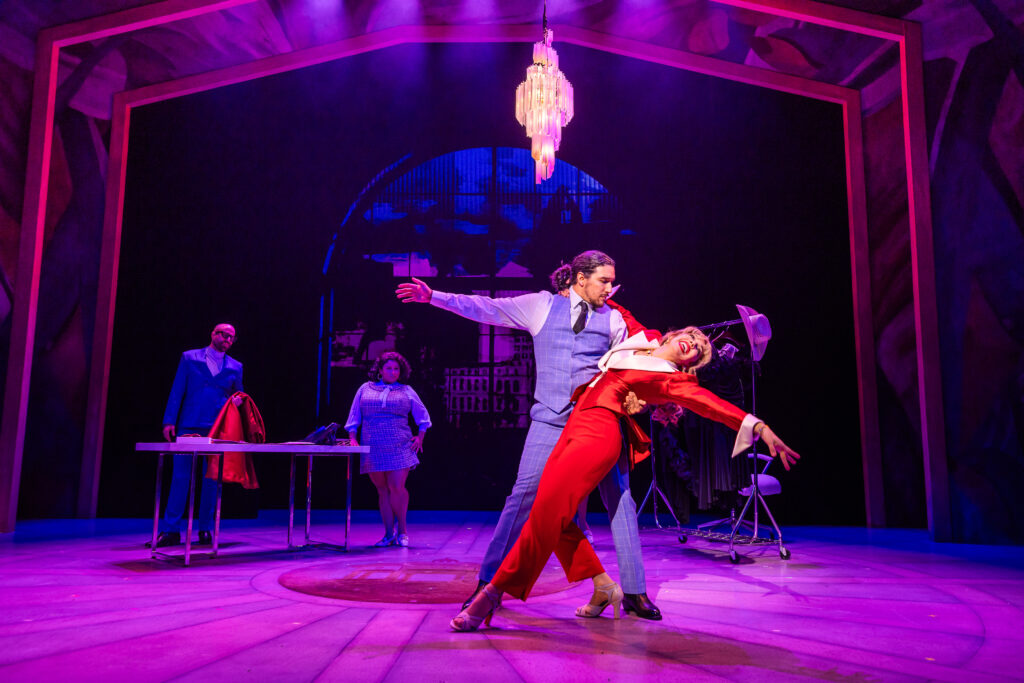
Photos by Nile Hawver and Maggie Hall
‘Real Women Have Curves: The Musical.’ Music & lyrics by Joy Huerta and Benjamin Velez, book by Lisa Loomer. Directed and choreographed by Sergio Trujillo. Music Supervisor Nadia DiGiallonardo; Music direction by Robeto Sinha. Scenic design by Arnulfo Maldonado. Costume design by Wilberth Gonzalez and Paloma Young. Lighting design by Natasha Katz. Sound design by Walter Trarbach. Video design by Hana S. Kim. At the American Repertory Theater’s Loeb Drama Center, Cambridge, through January 21, 2024.
by Linda Chin
Like the ad campaign from my childhood about Levy’s Real Jewish Rye, you don’t have to be Latinx to love Real Women Have Curves: The Musical, an exuberant and empowering production enjoying its world premiere at the American Repertory Theater. Set in the summer of 1987 in Boyle Heights, LA, home to a growing population of Hispanic and Latino residents, the story centers on the three “real women” of a Mexican family. Matriarch Carmen Garcia (Justina Machado) is a housewife and traditional, old-fashioned wife to her husband Raúl, a house painter (Edward Padilla), and mother to two daughters. The eldest, Estela (Florencia Cuenca), runs a small dressmaking shop but aspires to be a designer. The youngest, new HS graduate Ana (Lucy Godínez), was born in the US and is a citizen, aspires to go to college and pursue a writing career. Despite the many bumps and curves in their immigration and life journeys, all three “Garcia Girls” have not lost their accents nor lost sight of their big dreams. But they, like all of us, are desperate to be seen for their authentic selves, beyond their curves and the stereotypes society has placed on them.
And you don’t have to be in a mother-daughter, sibling-sibling, cross-generation or cross-cultural relationship, a two parent-one child or one parent-two child triangle, or the child of immigrant parents (or, like me, all of the above) to relate to Real Women Have Curves. Estela is unexpectedly offered a life-changing opportunity – a highly remunerative commission of producing 200 dresses in three weeks – but needs additional seamstresses. Carmen has the time, skills, and motivation to pitch in also but volunteers Ana, who cannot sew a button or iron a dress but can help with business matters and speaks excellent English. Estela does not need or want Ana’s help and Ana has future plans of her own (that she has not yet disclosed to her family), so Carmen’s interventions create issues between her daughters as well.
Like most real women with curves, like most moms, like most immigrants including my own Chinese mom, Carmen is resourceful and resilient, courageous and fierce. She’s sacrificed a lot to support her family back home and suppresses many of her own hopes and dreams for the sake of her new family in America. She also feels unacknowledged and unseen, lonely, and suppresses her emotions. Left unspoken, these feelings leak out. When Ana arrives, apologetically, late to the dinner table, her mother tells her she can stand to skip a meal. When Ana excitedly shares that she secured a summer internship at the local newspaper, Carmen says it’s useless because it is unpaid and persists in pushing Ana to work at the shop (the irony of that also being an unpaid job doesn’t register with Carmen). When Ana finally summons up the courage to share that she’s been accepted to her dream school – Columbia University – with a full scholarship (!), Carmen is horrified (about her moving to a city “filled with drugs”) and refuses to give Ana her blessing. When Ana protests, “What if I have bigger dreams?” her mother responds, “Sleep less.” (Words have power; those two words uttered by my own mother explain why I’ve always been an insomniac).
But this is a musical, where storytellers express and evoke emotions through words, song, and dance, and much credit goes to the strong and soulful book by Lisa Loomer, music & lyrics by Joy Huerta and Benjamin Velez (I’m still smiling about the rhyming lyrics “nozzle” and “menopausal” in the song “Adios Andres”), music direction by Robeto Sinha, and direction and choreography by Sergio Trujillo (who also helmed the similarly electrifying Arrabal at the ART, one of the highlights of the 2017 theater season). Scenic designer Arnulfo Maldonado, costume designers Wilberth Gonzalez and Paloma Young, lighting designer Natasha Katz, sound designer Walter Trarbach, and video designer Hana S. Kim also contribute masterfully to the storytelling.

The show includes some lovely ballads. In the song “Blood is Thicker than Mole,” Carmen explains why her daughter must put familia first (as she has for her own life given her cultural upbringing). Interestingly, Machado played Ana in the play version three decades ago and is now originating the role of Carmen in the musical. Her acting, life experience and commitment to this story shows.
Ana has been living under her parents’ roof for eighteen years and seeks new adventures and a bigger life outside the Boyle Heights bubble. One of the shop workers, Izel (Satya Chávez), also seeks freedom. Izel has recently arrived from Guatemala and discloses to Ana, with regret, that she is only seventeen (and a minor). Lying about her age and betraying her friend’s trust looms larger in Izel’s mind than her status as an undocumented immigrant. Together they deliver a pitch-perfect duet of the song “If I Were a Bird.” The image of flying like a bird over the rooftops of the city is complemented by a lovely video projection.
Rounding out the “real women” in the company are the five seamstresses: Shelby Acosta, Satya Chávez, Carla Jiminez, Jennifer Sánchez, and Sandra Valls. The opening “Making It Work” and showstopping Act Two “Curves” speak to finding your voice and using it, being seen and being proud of who you are, and show the power of diversity and unity, reminiscent of Kinky Boots and In the Heights.
Mrs. Wright, the entrepreneurial dress broker with a Cruella de Vil and Miranda Priestly-like leadership M.O. – who perhaps “took advantage” of immigrants to advance her agenda and get the work done is played by multi-talented Yvette González-Nacer. She is a fabulous actor and singer, can tango up a thunderstorm, and plays a mean violin solo as a member of the on-stage mariachi band in one of the transition scenes. But whether having a female villain makes sense in a feminist show or Mrs. Wright is a part of the sisterhood of “real women” is up for viewers to decide.
You also don’t have to be a real woman to feel seen by this show. Two talented male actors playing really nice men round out the featured cast of Real Women. They are the characters who see and feel seen by Ana in this feminist musical, who bust the stereotype of men lacking sensitivity and kindness. Family patriarch Raúl Garcia is a man of few words and few complaints. A painter by trade, he reveals that he too had dreams, and would prefer painting portraits of people than painting houses for gringos who don’t like colors except for white – and an occasional beige. He gives Ana his blessing to go to college and encourages Carmen to do so as well.

Fellow intern Henry (Mason Reeves) and Ana start off their relationship in the newsroom as rivals (to be assigned to an important lead story) but become friends and more. Henry is not a native Spanish speaker but surprises Ana with his acquired language skills, and plans to go East for college (to Wesleyan, like Lin Manuel-Miranda). Henry and Ana would be the first generation in their families to go to college (like Nina in In the Heights), but unlike Ana’s, Henry’s family is supportive. Henry also loves Latino culture and knows where to get the best tres leches in town, and they agree to have a dinner date at a restaurant with a live mariachi band. Their conversation flows freely and they dance to the live music like everyone is watching. (It turns out the adorable, lanky Henry and beautifully curvaceous Ana are terrific solo and partner dancers). This scene – about the indescribable feeling of being seen – is joyous.
And lest you think this moment is difficult to top, in a later scene in Henry’s bedroom, the pair decide to become physically intimate. The two book smart word nerds are awkward and tentative about how to begin but feel safe and trust each other enough to decide whether they’d be more comfortable with the lights “off” or “on.” Everyone who has been on a first date, felt insecure about their body, or wants to be seen and feel seen must see Real Women Have Curves. It runs through January 21, 2024 and I hope Huerta, Valez, and Loomer are at work on the sequel. For information and tickets, go to: https://americanrepertorytheater.org/


Very thorough review, catching so many of the overt and subtle dynamics contained in the musical, as well as insightful thumbnails of the main characters.
I thoroughly enjoyed the show, with its breathtaking and almost superhumanly executed production values.
One casting element that struck me was related to the concept that “real women have curves.” While almost all the female characters, have curves (are fleshy), only the female character of Mrs. Wright is notably lean. Could her dubious integrity in the plot make her not a “real woman”? Interesting comment on and revision of the societal bias.